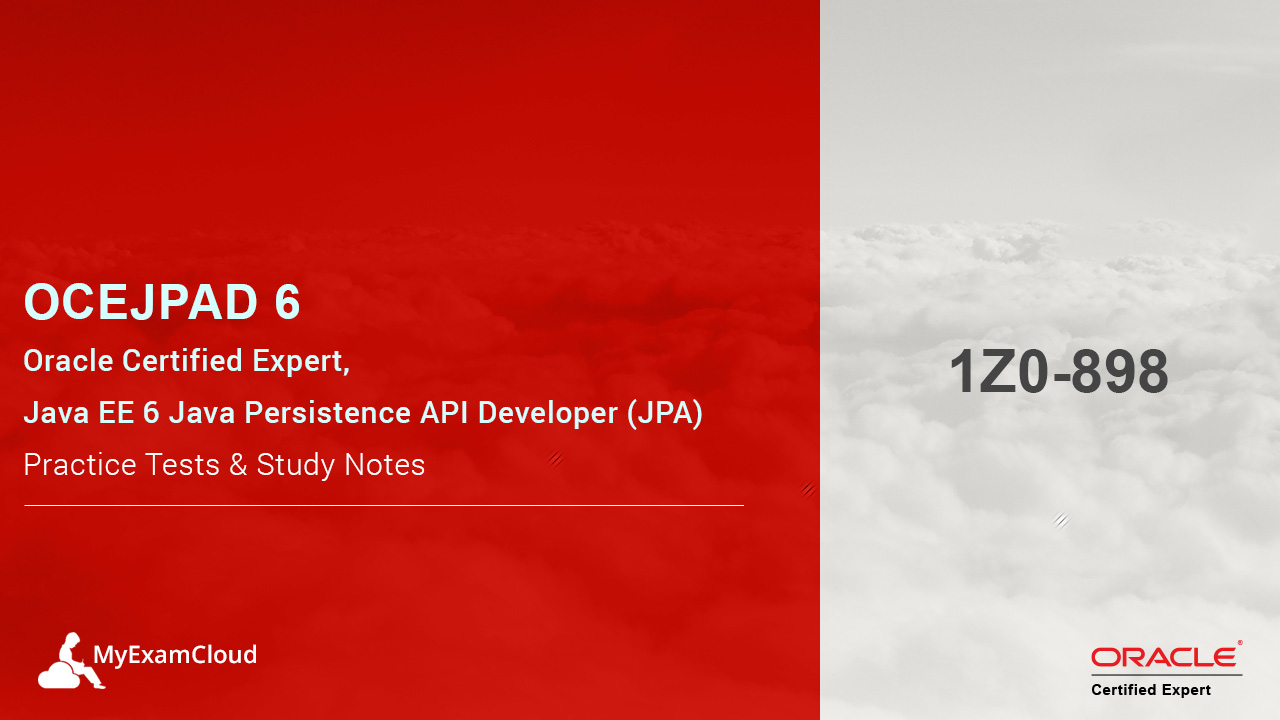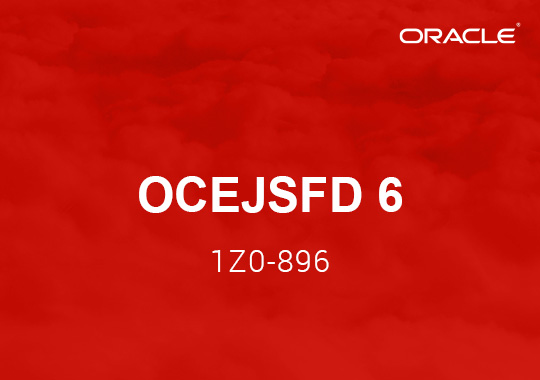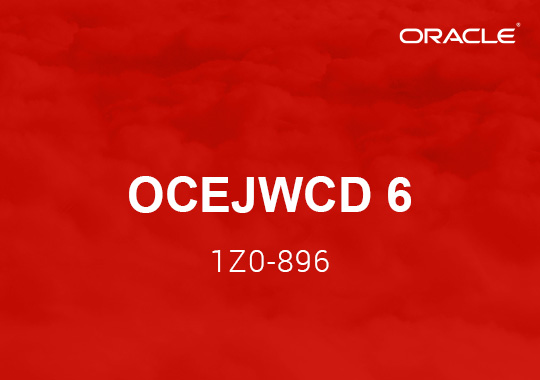OCEJPAD 6 Practice Tests - 1Z0-898 Mock Exams
MyExamCloud OCEJPAD 6 practice tests helps you to pass the Java EE 6 Java Persistence API Developer Certified Expert exam in first attempt. Prepare with one of the best OCEJPAD 6 Study Course developed by Java Certified Experts. 100% Test Pass Guarantee.
OCPJP 8 Upgrade (All Versions) Practice Tests and eBooks are available online at MyExamCloud Exam Simulator. This course contents can be accessed from PC, Mac, iPhone®, iPad®, Android™ Device. Mobile Apps available on iTunes and Android stores.
What is inside?
Inside MyExamCloud's OCEJPAD 6 practice test solutions
-
1
Set Your Goals
In MyExamCloud dashboard, you can set the goals against the topic. So you can easily check how you accomplish your goals.
-
2
Free OCEJPAD 6 Practice Tests
OCEJPAD 6 practice mock exam tests your programming skills in each exam objective. (MyExamCloud Practice Exams)
-
3
4 - Mock Exams
MyExamCloud OCEJPAD 6 practice test offers four practice mock exams with detailed explanations and correct answers.
-
4
2 - Quiz Exams
MyExamCloud OCEJPAD 6 training simulator offers two quiz tests that covers all real exam topics
-
5
3 - Flash Card Quiz Exams
MyExamCloud OCEJPAD 6 training simulator also offers three review quiz exams that covers all real exam topics
-
6
2 - Study Notes
MyExamCloud OCEJPAD 6 training lab offers two study notes (eBook) that covers all real exam topics (MyExamCloud eBooks)
-
7
Topic Based Questions
Study mode to access topic based questions
-
8
Answer with Explanation
MyExamCloud OCEJPAD 6 exam questions & answers, along with exhaustive explanations.
-
9
Exam Report
MyExamCloud reports to assess performance history, strengths & weaknesses against each topic
-
10
Goal Tracker
MyExamCloud goal tracker used to track your goals and shows how you accomplish your goals
-
11
Focus Lab
MyExamCloud focus lab to pinpoint your weak areas, it will help you to complete your self-preparation
-
12
Lifetime License
MyExamCloud platform gives you unlimited lifetime access, any where, any time and any device (Smart Phones / Tablets)
Who created MyExamCloud OCEJPAD 6 Practice Tests?
OCEJPAD 6 simulator providing you with complete preparation material for Java EE 6 Java Persistence API Developer Certified Expert Exam, along with mock and quiz questions. Each and every mock exam question content at MyExamCloud has been created by highly qualified Java Experts. They are highly qualified individuals, who have 15 years of experience in Java EE technologies.
The OCEJPAD 6 (Oracle Certified Expert, EE 6 Java Persistence API Developer) certification improves Java EE database integration tier technology design and development skills. This Java Certification tests Java EE 6 JPA key concepts, entity relationships, design robust entity model, CRUD operations, data validation, performance optimization, transaction & locking, ORM techniques, static & dynamic queries, and criterial API. Java EE 6 specification has been updated for these new features, so the experienced Java EE developers also need to learn this new changes by preparing for this exam.
Exam Process
Exam Number: 1Z0-898
Exam Title: Java EE 6 Java Persistence API Developer Certified Expert
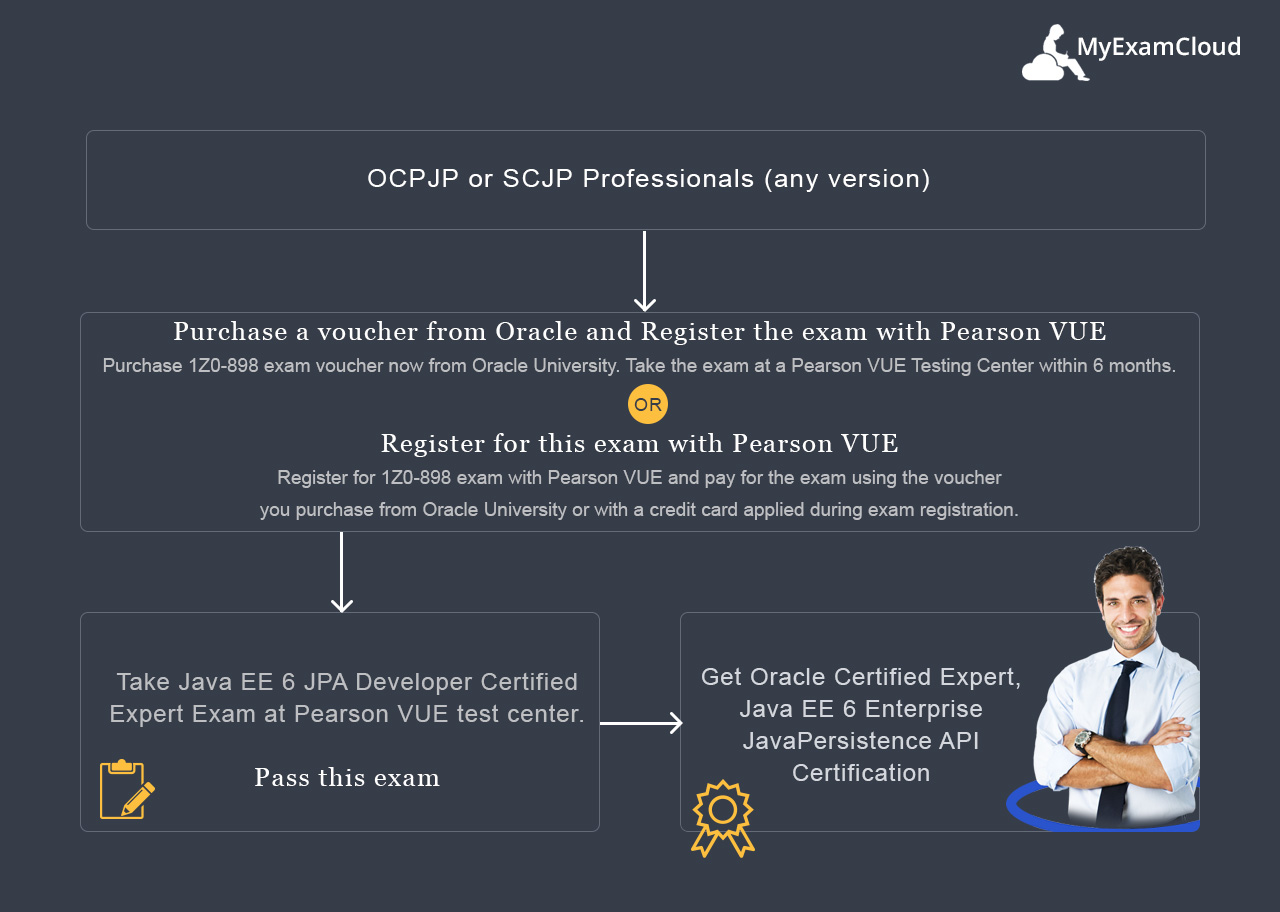
Passing this exam is on of the requirement to earn Oracle Certified Expert, Java EE 6 Java Persistence API Developer. This assignment has been validated EE 6.
| Number of Questions: |
64 Questions |
| Exam Duration |
135 Minutes |
| Passing Score: |
61% |
| Exam Format |
Multiple Choice
(which can have single or multiple answers) |
| Validated Against |
Java SE 6 |
| Exam Price |
Price May vary from Country to country. Refer Oracle site for latest pricing. |
The real exam is a computer based test provided by pearsonvue and it can be taken from any local test centers in your country.
Who can take OCEJPAD 6?
Set The New Java Standard With Java EE 6 JPA Certification: Java EE 6 significantly changes the business & persistence tier components and APIs. Java EE 6 JPA Certification gives you the tools to make the most of new features. The Java EE 6 Oracle Certified Expert (OCE) JPA Certification provides a foundational understanding of Java EE Integration Tier as well as JPA programming in general. So it suits for most Java EE Professionals starting from beginner to expert.
- Java EE Aspirants
- Java EE Developer looking for Job
- Java EE Trainers
OCEJPAD 6 Sample Question
The following practice question is taken from MyExamCloud OCEJPAD 6 Study Plan.
Question:
Which statement about entity manager is true?
Choices
Choice A: A container-managed entity manager must be a JTA entity manager.
Choice B: An entity manager injected into session beans can use either JTA or resource-local transaction control.
Choice C: An entity manager created by calling the EntityManagerFactory.createEntityManager method always uses JTA transaction control.
Choice D: An entity manager obtained through resource injection in a stateful session bean can use a resource-local EntityTransaction for transaction control.
|
Answer and Explanation:
Choice A is correct
With a container-managed entity manager, an EntityManager instance"s persistence context is automatically propagated by the container to all application components that use the EntityManager instance within a single Java Transaction Architecture (JTA) transaction.
JTA transactions usually involve calls across application components.
To complete a JTA transaction, these components usually need access to a single persistence context. This occurs when an EntityManager is injected into the application components by means of the javax.persistence.PersistenceContext annotation.
The persistence context is automatically propagated with the current JTA transaction, and EntityManager references that are mapped to the same persistence unit provide access to the persistence context within that transaction.
By automatically propagating the persistence context, application components don?t need to pass references to EntityManager instances to each other in order to make changes within a single transaction. The Java EE container manages the life cycle of container-managed entity managers.
To obtain an EntityManager instance, inject the entity manager into the application component:
@PersistenceContext
EntityManager em;
|
17 OCEJPAD 6 Practice Questions - Free
You can access 17 Oracle Certified Expert EE 6 Java Persistence API Developer Practice Questions, from MyExamCloud Exam Simulator Free 1Z0-898 Java EE 6 Java Persistence API Developer Certified Expert Practice Mock Exam
Take Free Practice Test
After OCEJPAD 6 Exam
Within 30 minutes of completing your OCEJPAD 6 Certification exam, you will receive an email from Oracle notifying you that your exam results are available in CertView. If you have previously authenticated your CertView account, simply login and select the option to "See My New Exam Result Now."
If you have not authenticated your CertView account yet at this point, you will need to proceed with your account authentication.
Authentication requires an Oracle Single Sign On username and password and the following information from your Pearson VUE profile: email address and Oracle Testing ID. You will be taken to CertView to log in once your account has been authenticated.
Sample OCEJPAD 6 Certificate
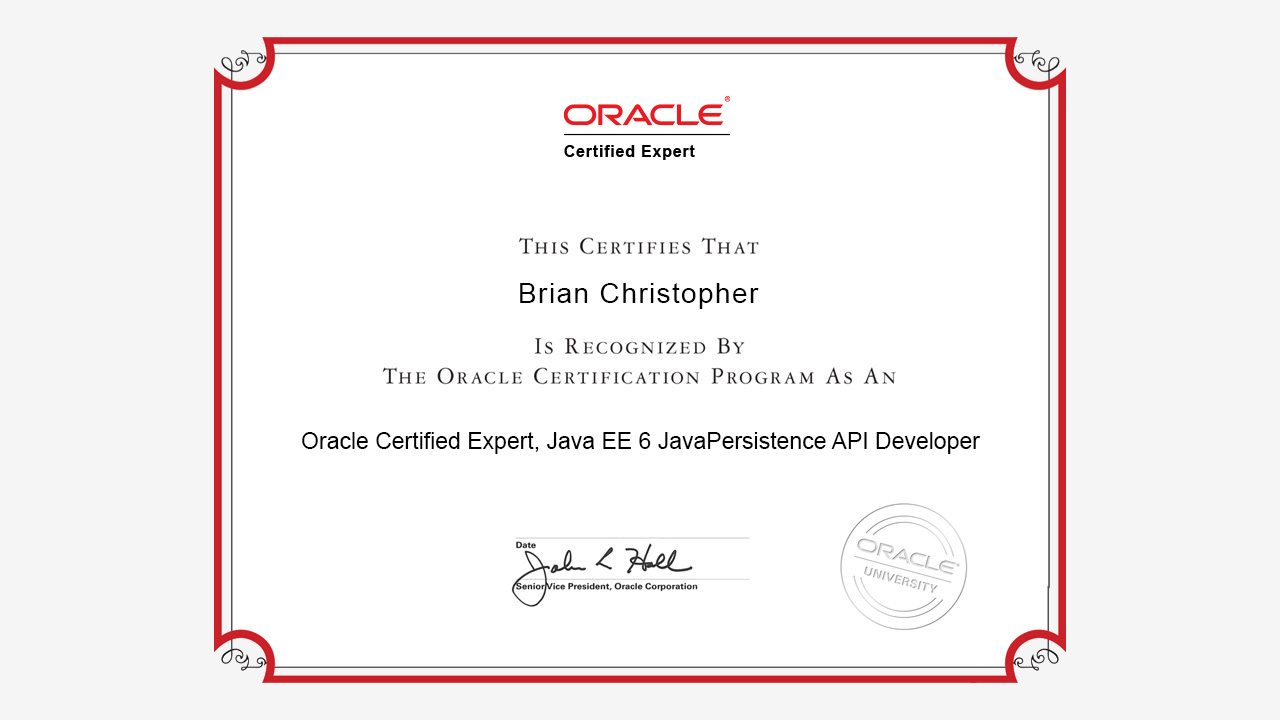
OCEJPAD 6 Benefits
The reason for taking Oracle Java Certification is to differentiate general programmers from certified experts. You may get additional benefits like getting a good job, salary hike, designation changes, role changes and higher promotion.
Stand out from the millions of Java crowd. Increase your marketability with OCEEJBD 6 Certification on the most used programming language in the world - Java.
Oracle Certified JPA Developers are familiar with the JPA coding experience of entities. Through careful exam preparation, they should also gain an understanding of entity design, best practices, transaction management, locking fundamentals, and security.
After completing EJB and JPA certifications you can easily complete Oracle Certified Enterprise Architect (OCMJEA) certification. This certification plays vital role in architecture and designing Java Platform, Enterprise Edition technology-compliant applications that are scalable, flexible, and highly secure.
How to register for OCEJPAD 6
- Step 1:Oracle :: Pearson VUEOpen this page, If you are a first time visitor then click on Create an account
- Step 2:Click on Proctored Exams
- Step 3:You will see a screen to search exam. Enter the exam code you want to give. You can get exam code details at Java Certifications MyExamCloud Exam Collections
- Step 4:You will see the exam name, fees for the exam and language of exam in the screen, Click on Schedule this exam.
- Step 5.You will see Confirm Exam Selection screen, click on the Proceed to Scheduling.
- Step 6. Now, Enter into the search box, the near by place for test center. Select the test center and click on Next.
- Step 7.Select Date and Time on which you will write your exam.
- Step 8.Check the information again, date and time. After confirming then click on the Proceed to Checkout.
- Step 9.After that you need to check the information and enter the credit card details.
Congrats, you have successfully scheduled your Java Certification exam.
OCEJPAD 6 Topics
|
Overview of the Java Persistence API
- Describe the basics of Object Relational Mapping (ORM)
- Define the key concepts of the Java Persistence API (entity, entity manager, and persistence unit)
Introducing the Auction Application
- Describe the auction application
- Define the domain objects of the auction application
- Describe the implementation model for the auction system
Java Persistence API Entities
- Describe the difference between objects and entities
- Describe the difference between persistent fields and properties
- Identify and use common Java Persistence API annotations, such as @Entity, @Id, @Table, and @Column
Understanding the Entity Manager
- Describe the relationship between an entity manager, a persistence context, and a persistence unit
- Describe the difference between a container-managed entity manager and an application-managed entity manager
- Describe the entity life cycle
Modeling Entity Relationships
- Examine association relationships in the data and object models
- Use relationship properties to define associations
- Implement one-to-one unidirectional associations
- Implement one-to-one bidirectional associations
- Implement many-to-one/one-to-many bidirectional associations
- Implement many-to-many bidirectional associations
- Implement many-to-many unidirectional associations
- Examine fetch and cascade mode settings
Entity Inheritance and Object-Relational Mapping
- Examine entity inheritance
- Examining object/relational inheritance hierarchy mapping strategies
- Inherit from an entity class
- Inherit using a mapped superclass
- Inherit from a non-entity class
- Examine inheritance mapping strategies
- Use an embeddable class
Persisting Enums and Collections
- Persist entities that contain enums with @Enumerated
- Persist entities that contain lists with @ElementCollection
- Persist entities that contain maps with @ElementCollection
Introduction to Querying
- Find an Entity by its primary key
- Understand basic Java Persistence API query language queries
- Understand native SQL queries
- Understand basic Criteria API queries
Using the Java Persistence API Query Language
- Examine the Java Persistence API query language
- Create and use the SELECT statement
- Create and use the UPDATE statement
- Create and use the DELETE statement
Using the Java Persistence API Criteria API
- Contrast queries that use the Criteria API with queries that use the Java Persistence query language
- Describe the metamodel object approach to querying
- Create Criteria API queries
Using the Java Persistence API in a Container
- Use the Java Persistence API from a servlet
- Use the Java Persistence API from a stateless session bean
Implementing Transactions and Locking
- Describe the transaction demarcation management
- Implement container-managed transactions (CMT)
- Interact programmatically with an ongoing CMT transaction
- Implement bean-managed transactions (BMT)
- Apply transactions to the Java Persistence API
Advanced Java Persistence API Concepts
- Specify composite primary keys
- Override mappings with the @AttributeOverride and @AssociationOverride annotations
Understand entity listeners and callback methods
|
Testimonial
Luqman Ahmad
I purchased JPA OCE training lab and passed it in my first attempt. They are absolutely right plan, practice and achieve. Now I have bought the EJB 6 OCE training lab as well. Keep it up EPractize Labs!!!!
